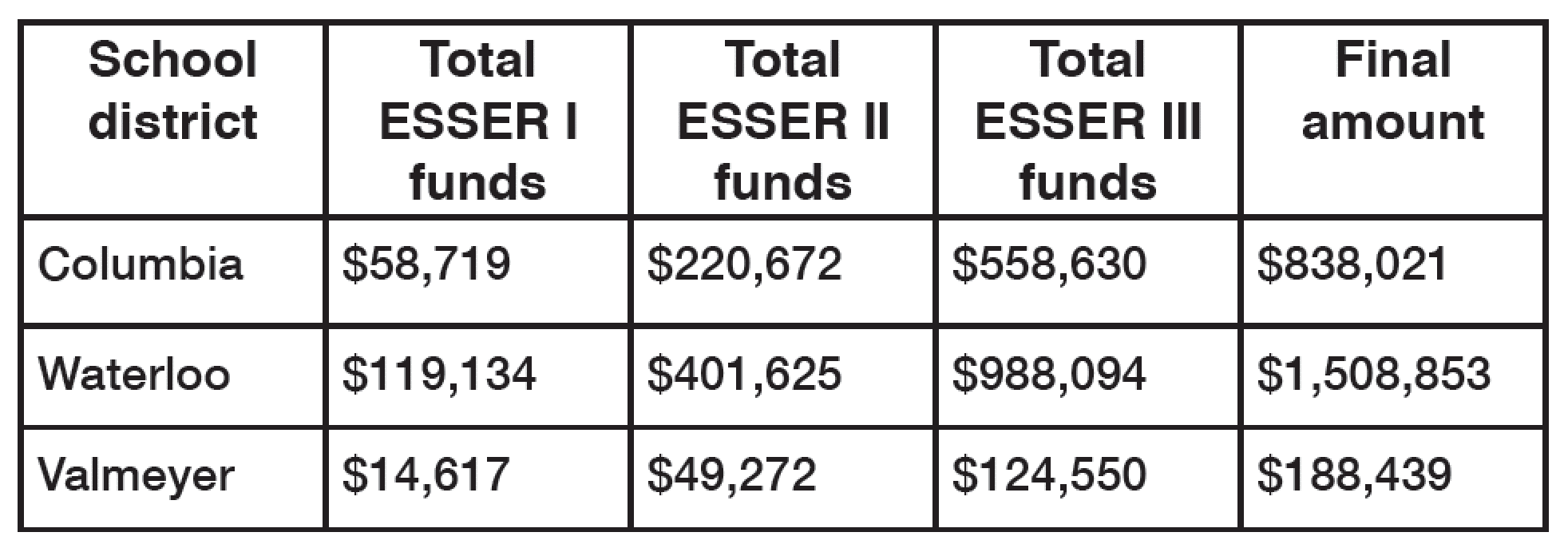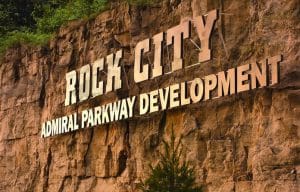How schools are spending COVID funds

Currently, schools across the state are in the process of determining how they will use the largest installment of American Rescue Plan’s Elementary and Secondary School Emergency Relief funds.
Initially, the Waterloo school district was slated to receive an estimated $901,557 for the third round of ESSER funds and Columbia $495,358.
However, the state recently announced additional ESSER III funding for Illinois public schools.
With this update, Waterloo will be receiving an additional $86,637, bringing its total amount of ESSER III funds to $988,094.
Columbia will be receiving an additional $63,272, making its third round total $558,630.
The state earmarked an additional $13,946 for Valmeyer, bringing its total estimated ESSER III funds $124,550.
“Rather than having schools write a fourth ESSER grant, they have included these funds with ESSER III,” Waterloo Curriculum Coordinator John Schmieg, who writes the grants, said of these additional funds. “It is my understanding that the state received more federal funds and the governor directed some of them toward public schools.”
As the Republic-Times previously reported, these figures are calculated based on a district’s perceived need, which takes into consideration factors such as community poverty rate. Because of this, Waterloo, Columbia and Valmeyer’s allocated funds for all three installments are lower than those of other area districts.
Additionally, ESSER funds are only to be used toward COVID-related expenditures.
While Columbia’s spending plan for its ESSER III funds has already been approved by the state, Waterloo is currently working through the multi-step process of budgeting its total third round funds, Schmieg explained. This public input requirement was not imposed for the first two rounds, Schmieg said.
As of now, Schmieg is preparing to meet with a designated group of parents, teachers and the board’s finance committee to map out how they wish to spend this $988,094. He estimates the committee’s work will be finished within the next month, at which point they will then post the budget for public comment.
Schmieg said just like with Waterloo’s 2021-22 Safe Return to School Plan community review process, the budget will be emailed to all parents along with a link to submit input.
In fact, school districts across the state had to craft similar plans as a condition of receiving ESSER relief.
“The federal government wanted us in-person, so in order to receive these ESSER funds, we had to provide a plan for how we would provide in-person learning,” Schmieg said.
Columbia Superintendent Chris Grode said feedback on Columbia’s Return to School 2021-22 plan directly influenced how the district’s estimated ESSER III funds were planned to be allocated.
He said input on the plan and the budget echoed the government’s sentiment that students needed to be in school.
“My community made it quite clear that we need in-person instruction, that the social-emotional aspect of remote learning was hard on the kids, (so) we needed to be in-person,” Grode said.
Grode said in turn, much of Columbia’s ESSER III funds are earmarked for things to address the impacts of remote learning, including learning loss. As Schmieg shared, schools must devote at least 20 percent of ESSER III funds to rectifying learning loss.
“The majority of (our ESSER III) for teachers (and) instructional staff after school and during the summer. We’re going to have summer school again next year because of (COVID),” Grode said. “(The funding also includes) benefits for the teachers and then some professional development money for social-emotional learning.”
Schmieg estimates the committee’s budget will show much of Waterloo’s ESSER III pool will go to keeping class sizes low and for the salaries and benefits of those hired to achieve this goal. He said it will most likely also include teachers hired to quell learning loss.
“I would say the majority of our ESSER III funds will be paying for class-size reduction teachers this year, some of those that we (already) put in place,” Schmieg said. “We have to spend a certain percentage on learning loss, so (for) summer school we hired an additional reading teacher at the kindergarten through third grade level to help with reading learning loss. Any of those things that took place because of the pandemic we can spend ESSER money on.”
Valmeyer Superintendent Eric Frankford said his district will be sending out an email this week seeking parent input on its ESSER III budget. After reviewing the feedback, the budget will then be amended as the district deems necessary.
As Schmieg explained, ESSER III funding, is not given to the districts all at once.
“It comes in as we spend it. We are paid back quarterly for our expenditures,” Schmieg simply stated.
Past ESSER rounds
While Columbia and Valmeyer have already spent all of their ESSER I funding, Waterloo has spent most of its, Schmieg said. Both districts allocated much of round one funds toward technology for remote learning, specifically toward Chromebooks.
In fact, over 77 percent of Waterloo’s ESSER I budget reflects expenditures for Chromebooks, “access points, internet hot spots, wiring, switches … and related supplies” to upgrade technology infrastructure to its standard of remote learning.
Grode said Columbia found a way to get in front of the high demand for Chromebooks.
“One of the things we did that was really smart was we made a decision early to get those Chromebooks in the one-to-one, so we placed an order to get those Chromebooks in nice and early,” Grode said. “Other districts didn’t get their orders in and there was a mad rush of Chromebooks that year, and so we had our shipment for school to start. I know schools that didn’t have their Chromebooks when they started.”
Other big ticket items on Waterloo’s ESSER I and ESSER II budgets – which the district has a multiple-year spending plan for – are summer school costs, including salaries and benefits of these teachers.
The second-largest expenditure on Waterloo’s current ESSER II budget was for a particular class size reduction teacher at Waterloo High School which was budgeted for two years.
For Columbia, much of its ESSER II funds were earmarked for remote instructors, summer school teachers and supplies they needed, Grode noted.
“We hired four teachers in December to be the remote instructors for the primary,” Grode said. “We had six summer school teachers out of (ESSER II), and that didn’t cover all of it but it covered some of it, insurance and benefits for the teachers and then we had building instructional materials. So we bought some of the online programs that the teachers wanted to have. Then we also put money toward plastic barriers and cleaning supplies.”
Grode said he believes all of Columbia’s $220,672 ESSER II funding has been spent.
Frankford previously told the Republic-Times much Valmeyer’s $63,889 total from the first two rounds went toward personal protection equipment, sanitization equipment and remote learning supplies and technology.






